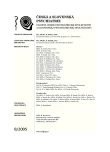Neuropsychiatric Symptomatology in Systemic Lupus Patients
Neuropsychiatrická symptomatologie u nemocných se systémovým lupusem
Cílem studie bylo vyhodnotit, zda se liší jednotlivé typy postižení centrálního nervového systému (CNS) u nemocných se systémovým lupus erytematodes (SLE) s neuropsychiatrickými projevy (NPSLE). V práci jsme prospektivně zpracovali a porovnali klinické nálezy, testy aktivity nemoci a výsledky pomocných vyšetřovacích metod u 70 nemocných s diagnózou NPSLE. Nemocní s NPSLE vykazují v MR nálezech ložiskové hyperintenzity v T2 vážených obrazech v bílé hmotě, velikost ložisek převážně nepřesahuje 3 mm, ložiska jsou nejčastěji uložena frontoparietálně a odpovídají nejspíše vaskulopatii, resp. vaskulitidě mozkových arteriol s mikrotrombózou a gliózou. Nález v likvoru je nespecifický, prokazuje přesněji poruchu hematoencefalické bariéry než postkontrastní MR zobrazení, a to až u 50 % nemocných. Postkontrastní MR zobrazení je ovlivněno kortikoterapií, a proto se u nemocných porucha bariéry nemusí zobrazit. Nenalezli jsme žádné specifické změny v paraklinických vyšetřeních u různých projevů neuropsychiatrického lupusu. Nebyla nalezena ani jejich korelace s aktivitou nemoci.
Klíčová slova:
systémový lupus erytematodes, klinické typy, pomocné vyšetřovací metody.
Authors:
V. Peterová 1; L. Linková 2; M. Olejárová 2; C. Dostál 2
Authors‘ workplace:
Oddělení MR Radiodiagnostické kliniky 1. LF UK, Praha
1; Revmatologický ústav 1. LF UK, Praha
2
Published in:
Čes. a slov. Psychiat., 101, 2005, No. 8, pp. 405-411.
Category:
Original Article
Overview
The aim of the study was to evaluate significant differences among the various types of central nervous system (CNS) affection in patients with systemic lupus erythematosus (SLE) with neuropsychiatric manifestation (NPSLE). The clinical findings of 70 patients with diagnosis of SLE with neuropsychiatric symptomatology were prospectively recorded and compared with activity indices and findings of other auxiliary methods. NPSLE patients have the focal hyperintensities in the white matter on MR findings in the T2 weighted images. The lesions mainly reach the size up to 3 mm and they are localized predominantly in frontal and parietal regions of both hemispheres. These signal changes are supposed to be caused by the vasculopathy or vasculitis of cerebral arterioles with microthrombosis and gliosis. Cerebrospinal fluid (CSF) analysis is nonspecific; it shows the blood brain barrier (BBB) disruption more precisely than postcontrast MR scans, being present in up to 50% of patients. Postcontrast MRI scans are influenced by corticotherapy and therefore need not show signal changes. We did not find any specific changes in paraclinical investigations caused by various types of neuropsychiatric symptomatology. There was no correlation between them and the activity of the disease.
Key words:
systemic lupus erythematosus, clinical types, auxilliary methods.
Labels
Addictology Paediatric psychiatry PsychiatryArticle was published in
Czech and Slovak Psychiatry

2005 Issue 8
- Memantine in Dementia Therapy – Current Findings and Possible Future Applications
- Memantine Eases Daily Life for Patients and Caregivers
- Hope Awakens with Early Diagnosis of Parkinson's Disease Based on Skin Odor
- Deep stimulation of the globus pallidus improved clinical symptoms in a patient with refractory parkinsonism and genetic mutation
Most read in this issue
- Psychobiological Reactions on Stress and Trauma
- Ability to Understand Non-verbal Communication by Psychiatric Inpatients
- Neuropsychiatric Symptomatology in Systemic Lupus Patients
- Profile of Cognitive Functions in Patients with Depression and Schiozphrenia
